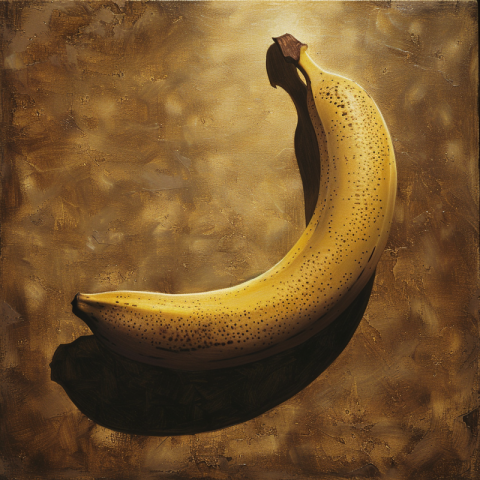











The Banana: A Globally Popular and Nutritious Fruit - A Sweet Staple
The banana, a curved, yellow fruit that grows in bunches, is one of the world's most popular and widely consumed fruits. Its sweet flavor, creamy texture, and convenient portability have made it a staple food in many cultures. Bananas are not only delicious but also a good source of essential nutrients, including potassium, vitamin B6, and fiber.
1. The Origins of the Banana: A Tropical Treasure
The banana's origins can be traced back to Southeast Asia and the Pacific Islands:
- It's believed that bananas were first domesticated in Papua New Guinea around 8000 BCE.
- From there, banana cultivation spread throughout Southeast Asia, India, and eventually to Africa.
- Arab traders played a significant role in introducing bananas to the Middle East and parts of Africa.
- Bananas were brought to the Americas by Portuguese sailors in the 16th century.
2. Banana Varieties: A Spectrum of Shapes and Flavors
While the Cavendish banana is the most common variety found in supermarkets, there are hundreds of different types of bananas grown around the world:
- Cavendish Banana: The most widely cultivated and exported banana, known for its sweet flavor and creamy texture. It is the standard yellow banana found in most grocery stores.
- Gros Michel Banana: Previously the dominant export banana, largely replaced by the Cavendish in the mid-20th century due to its susceptibility to Panama disease. It is known for being more flavorful than the Cavendish.
- Lady Finger Banana: Small, sweet bananas with a thin skin.
- Red Banana: Bananas with a reddish-purple skin and a slightly sweeter flavor than Cavendish bananas.
- Plantains: A type of banana that is starchier and less sweet than dessert bananas, typically cooked before eating.
3. Nutritional Powerhouse: The Health Benefits of Bananas
Bananas are a good source of several important nutrients:
- Potassium: Bananas are renowned for their high potassium content, an electrolyte that helps regulate blood pressure, muscle function, and fluid balance.
- Vitamin B6: Important for brain development and function, as well as metabolism.
- Fiber: Bananas contain dietary fiber, which aids digestion and can help promote satiety.
- Vitamin C: An antioxidant that supports immune function.
- Manganese: A trace mineral involved in bone formation and metabolism.
- Carbohydrates: Bananas are a good source of carbohydrates, providing energy for the body.
4. Culinary Uses: From Breakfast to Dessert
Bananas are incredibly versatile in the kitchen:
- Fresh Eating: Bananas are a convenient and delicious snack on their own.
- Smoothies: Bananas add creaminess and sweetness to smoothies.
- Baking: Bananas are a key ingredient in banana bread, muffins, and other baked goods.
- Breakfast Foods: Bananas are often added to oatmeal, cereal, and yogurt.
- Desserts: Bananas can be used in desserts like banana pudding, banana splits, and banana cream pie.
- Frozen: Frozen bananas can be used in smoothies or to make "banana nice cream."
5. Bananas and Sports: A Natural Energy Source
Bananas are a popular food among athletes:
- They provide a quick source of carbohydrates for energy.
- The potassium in bananas helps to prevent muscle cramps.
- They are easily digestible.
6. Banana Production: A Global Industry
Bananas are grown in tropical and subtropical regions around the world:
- Major banana-producing countries include India, China, the Philippines, Ecuador, and Brazil.
- The banana industry is a major global industry, employing millions of people worldwide.
- Most bananas grown for export are of the Cavendish variety.
7. The Threat of Panama Disease: A Challenge to Banana Production
The banana industry faces a significant threat from Panama disease, a fungal disease that attacks banana plants:
- The Gros Michel variety, once dominant, was nearly wiped out by an earlier strain of Panama disease in the mid-20th century.
- The Cavendish variety, which is resistant to the earlier strain, is now threatened by a new strain of the disease called Tropical Race 4 (TR4).
- Scientists are working to develop disease-resistant banana varieties.
8. Bananas in Culture and Symbolism
- In some cultures, bananas are a symbol of prosperity and fertility.
- The term "banana republic" was coined to refer to politically unstable countries in Latin America whose economies were heavily reliant on banana exports.
- Bananas have also been featured in art, literature, and popular culture.
9. The Future of Bananas
- The banana industry is working to address the challenges posed by Panama disease and to develop more sustainable growing practices.
- Researchers are exploring the genetic diversity of bananas to find varieties that are resistant to disease and have desirable qualities.
- The demand for bananas is expected to continue to grow globally.
Conclusion:
The banana, with its sweet flavor, creamy texture, and impressive nutritional profile, is a truly remarkable fruit. From its origins in Southeast Asia to its status as a global food staple, the banana has a rich history and continues to play an important role in diets and cultures worldwide. Whether enjoyed fresh, baked into bread, or blended into a smoothie, the banana offers a delicious and healthy way to fuel our bodies and satisfy our taste buds. As the banana industry faces challenges and adapts to changing conditions, the banana's enduring popularity ensures that it will remain a beloved fruit for generations to come.
Banana, bananas, types of bananas, banana nutrition, banana benefits, Cavendish banana, Gros Michel banana, banana recipes, banana bread, banana muffins, banana smoothie, banana pudding, banana split, banana chips, plantains, how to ripen bananas, how to store bananas, banana history, where do bananas grow, banana production, Panama disease, banana republic, banana calories, banana potassium, health benefits of bananas, organic bananas, buy bananas online, banana facts.

